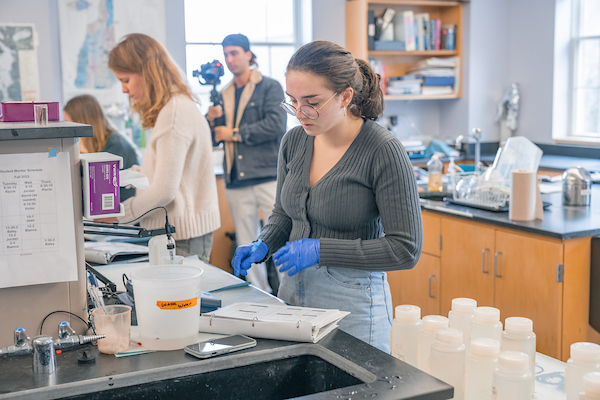Colby-Sawyer Students Uncover New Data Explaining Increased Frequency of Bacterial Blooms in Pleasant Lake
The students in Community-Based Research, a 300-level environmental science course spanning two semesters, are collaborating with the Pleasant Lake Protective Association and the town of New London on a watershed analysis project that focuses on Pleasant Lake.
“So far, the class has collected data from twenty-six different tributaries for the lake on twelve individual dates, which represents the most extensive surveying effort of the water body in its history,” explained David Lutz, assistant professor of environmental science and studies.
The purpose of the project is to investigate past and current water quality analysis — especially to identify potential stressors that can lead to toxic cyanobacteria algae blooms. Ten students are enrolled in the class, which is comprised of both juniors and seniors, and their work is guided by two faculty instructors; Lutz, and Nick Baer, professor of biology and environmental science, and also Teriko McConnell, manager of the Colby-Sawyer and Lake Sunapee Protective Association water quality laboratory. At the end of the fall semester, in Clements Hall in the Ivey Science Center, the group presented their mid-project findings to the college and New London community.
They began by presenting data from the New Hampshire Department of Environmental Service that shows the frequency of advisories and alerts concerning cyanobacteria throughout the state, spanning back to 2003. Data indicated that the frequency of algal blooms in general and cyanobacteria blooms specifically has been increasing to record high numbers in recent years. Students explained that this is a problem because according to the Environmental Protection Agency, cyanobacteria can be dangerous to humans and other animals.
All of the students in the class participated in sampling and lab work, but each also selected a particular area of interest as a specialization, such as writing, data analysis or GIS (geographic information systems) mapping.
“For the past few summers Pleasant Lake has experienced cyanobacteria blooms,” Sam Carus, a junior environmental science major, explained during the presentation. “So, to better understand contributions of excess nutrients within the watershed, the class has undertaken extended extensive sampling and sub-watershed delineation to begin to pinpoint areas of concern within this watershed.”
This means that the group is testing water samples to identify the source of the excess nutrients that are likely causing the harmful bacteria blooms.
The presentation began with a project overview and a list of objectives that the group hopes to accomplish within the scope of the project. Next, there was a thorough analysis of the history of agriculture in the area and how it pertains to the level of cyanobacteria in the water. This was followed by a discussion of field procedures and a review of previously collected lab data, as well as an analysis of results the group had captured thus far and its preliminary observations.
The students’ main conclusions were that blooms seem to follow a particular weather pattern — namely, that they tend to occur after one or more warm, sunny days followed by a day of heavy rain — and that the pollution seemed to be concentrated at several specific locations around the lake.
“To date, the students have learned how to develop a sampling strategy, how to measure important water quality parameters, and how to work with the surrounding community to better understand natural resource protection and management,” said Lutz.
During the spring semester, the group plans to continue sampling, with the goal of expanding data to include the winter and spring. They expect the data to reveal information about seasonal variations in water quality, which might be affected by factors like the application of road salt or snow melts. They also intend to obtain more samples from tributaries, including intermediate and ephemeral tributaries, to develop a better picture of the delineation of sub-watersheds and more thoroughly identify the source of contaminants.
Samples from this class will also contribute to a citizen science project called “all about arsenic” that measures arsenic in the New London drinking water. Lastly, students in Community-Based Research intend to continue sharing their findings through a community newsletter and seek additional ways to disseminate their results to the public.
“The project will continue in the spring term,” Lutz said, “and students will give a final presentation of their year-long efforts in late April to the surrounding community; we hope you can join us!”
